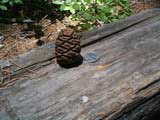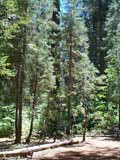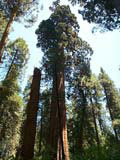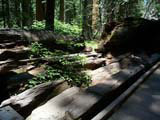Life Cycle of A Giant Sequoia
A giant sequoia tree
goes through a life cycle like any other plant. It first starts
out as a seed from a cone which sprouts, or 'germinates.' The
seed grows into a seedling, then after many, many years, into
a mature
tree. Often, after
the sequoia dies, other plants in the redwood forest start to
grow on the dead
tree. In this section
of the tour, you will learn more the sequoia life cycle.
Click on any photo
to see an enlargement.
The Cone
 All giant sequoia trees have cones. The tree starts
growing cones when it is ten years old. There are
male cones and female cones. The female cones are the ones that
make the seeds. Look at this photo closely. The cone from a giant
sequoia is very small compared to a grown tree. In fact, it is
only about the size of a chicken egg! The seeds are even smaller.
Each seed is only the size of a flake of oatmeal.
All giant sequoia trees have cones. The tree starts
growing cones when it is ten years old. There are
male cones and female cones. The female cones are the ones that
make the seeds. Look at this photo closely. The cone from a giant
sequoia is very small compared to a grown tree. In fact, it is
only about the size of a chicken egg! The seeds are even smaller.
Each seed is only the size of a flake of oatmeal.
In the spring, when conditions are right, the seeds
germinate, or grow. By the fall, the young sequoia
tree is only one or two inches tall.
top
Young Sequoia Trees
Young sequoias trees are called
seedlings. Seedlings can grow well only where there are not many
other trees and plants growing. That way, they do not have to
share the water and soil with the other plants. Only a few sequoia
seedlings grow into trees. Some are eaten by animals, and others
don't get enough sunlight or water.
 Here are some seedlings that have found a good place
to grow. Notice the shape of the young trees. Sequoias look like
upside-down ice-cream cones for the first 250 years of their life.
They are still considered young after all that time!
Here are some seedlings that have found a good place
to grow. Notice the shape of the young trees. Sequoias look like
upside-down ice-cream cones for the first 250 years of their life.
They are still considered young after all that time!
top
Mature Trees
 Giant sequoias reach full height when
they are between 500 and 750 years old. Can you imagine living
that long? They can grow to be around 250 feet tall and 30 feet
wide. They are the largest living trees in the world! Because
they grow so tall, sequoias grow bigger branches and thicker trunks
to help them keep their balance.
Giant sequoias reach full height when
they are between 500 and 750 years old. Can you imagine living
that long? They can grow to be around 250 feet tall and 30 feet
wide. They are the largest living trees in the world! Because
they grow so tall, sequoias grow bigger branches and thicker trunks
to help them keep their balance.
You can tell if a giant sequoia
is mature if the top of the tree looks rounded, like this one.
Also, most of the low branches break off and fall to the ground,
so the trunks are bare for 100 to 150 feet or more.
top
Death of a Sequoia
 Many old giant sequoias die after they
fall to the earth in powerful storms. The trunk of a dead sequoia
tree might lie on the forest floor for hundreds of years. Although
the tree is dead, the trunk is teeming with life! Many animals,
including mice, birds, and squirrels make their homes in the fallen
tree. Seeds from other plants in the forest start to grow on the
trunk because the dead wood has many vitamins that help young
plants grow. Here is a young dogwood tree growing on a fallen
sequoia trunk. Soon, the tree will be part of the soil of the
forest floor.
Many old giant sequoias die after they
fall to the earth in powerful storms. The trunk of a dead sequoia
tree might lie on the forest floor for hundreds of years. Although
the tree is dead, the trunk is teeming with life! Many animals,
including mice, birds, and squirrels make their homes in the fallen
tree. Seeds from other plants in the forest start to grow on the
trunk because the dead wood has many vitamins that help young
plants grow. Here is a young dogwood tree growing on a fallen
sequoia trunk. Soon, the tree will be part of the soil of the
forest floor.
top

Continue the tour!
Introduction
Parts of a Giant
Sequoia Tree
Fire Resistance
Other Plants
of the Giant Sequoia Forest
Glossary
Take the Quiz!
Try the Word
Search!
top
 All giant sequoia trees have cones. The tree starts
growing cones when it is ten years old. There are
male cones and female cones. The female cones are the ones that
make the seeds. Look at this photo closely. The cone from a giant
sequoia is very small compared to a grown tree. In fact, it is
only about the size of a chicken egg! The seeds are even smaller.
Each seed is only the size of a flake of oatmeal.
All giant sequoia trees have cones. The tree starts
growing cones when it is ten years old. There are
male cones and female cones. The female cones are the ones that
make the seeds. Look at this photo closely. The cone from a giant
sequoia is very small compared to a grown tree. In fact, it is
only about the size of a chicken egg! The seeds are even smaller.
Each seed is only the size of a flake of oatmeal.

